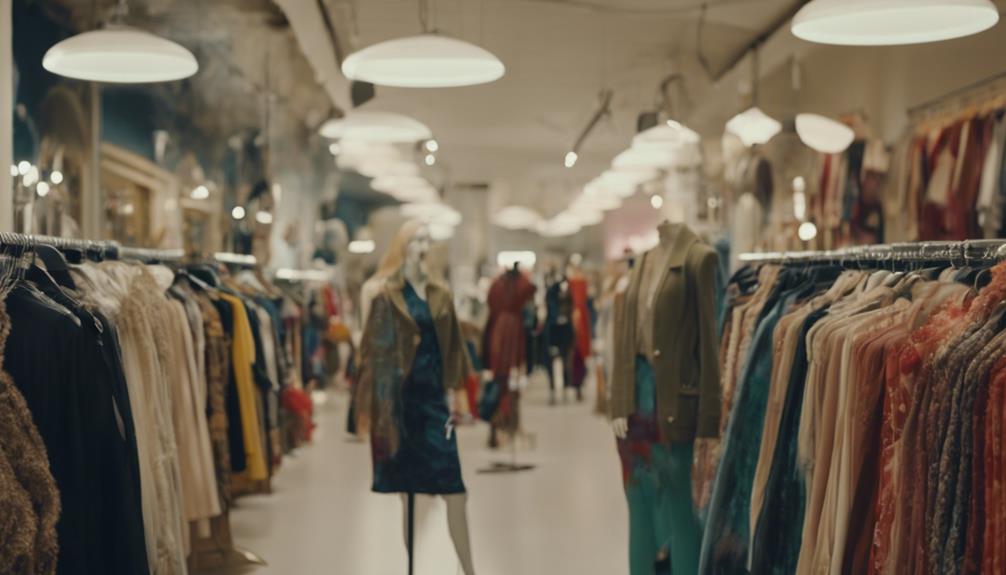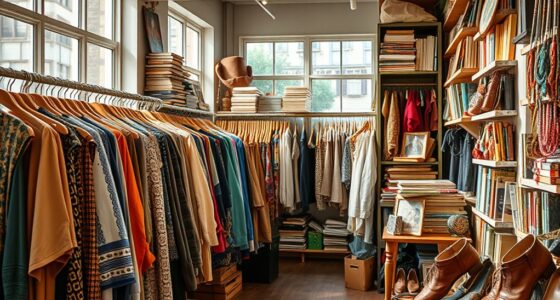Sustainability in the fashion industry can sometimes appear elitist. Many sustainable clothing options come with a higher price tag, making them unattainable for lower-income individuals who often cannot prioritize ethics over affordability. Fast fashion continues to thrive by providing budget-friendly alternatives, despite the negative impact on the environment. While luxury brands may promote sustainability, they do not always follow through with ethical practices. This leaves ethical consumption feeling like a privilege reserved for the wealthy, leaving behind those who are economically disadvantaged. Recognizing and understanding these patterns is crucial for promoting inclusivity within the fashion industry. Interested in learning how to make sustainable fashion more accessible? There is much more to discover on this subject.
Key Takeaways
- Sustainable fashion often has higher price tags, making it inaccessible to lower-income consumers and reinforcing class divides in ethical consumption.
- Fast fashion targets economically disadvantaged groups, creating a false sense of affordability while perpetuating significant environmental harm.
- Many misconceptions exist, equating luxury with sustainability, yet luxury brands frequently lack transparency and ethical practices.
- Marginalized communities contribute to fashion trends but are overlooked in sustainability discussions, highlighting the need for inclusivity and recognition.
The Class Divide in Fashion
The class divide in fashion reveals how sustainable choices often feel out of reach for lower-income consumers, who prioritize affordability over eco-friendly options. The sustainable fashion movement often targets middle to high-income families, leaving working-class individuals feeling excluded. Fast fashion giants thrive by catering to economically disadvantaged groups, making it difficult for you to engage in discussions about shopping sustainably.
When you're on a tight budget, the allure of cheap, trendy clothing can overshadow the principles of sustainability. You may find it challenging to justify spending more on a slow fashion piece when fast fashion offers lower prices and immediate gratification. This creates a cycle where financial constraints dictate your clothing choices, pushing you towards brands that prioritize cost over ethics.
Conversations about sustainable fashion often ignore the economic realities you face, reinforcing classism within the industry. As a result, the narrative surrounding sustainable fashion can inadvertently alienate those who'd benefit the most from it. This divide underscores the need for a more inclusive approach to sustainable fashion, one that considers affordability alongside environmental responsibility. For many individuals, the cost of sustainable fashion is simply unattainable, especially when compared to fast fashion options. This is why it’s important to acknowledge and address the economic disparities within the industry. In addition, mainstream brands like Zara’s sustainability practices are often overshadowed by their fast fashion reputation, making it difficult for consumers to make informed decisions about their purchases. Therefore, a more inclusive approach to sustainable fashion must also include holding large corporations accountable for their production practices.
It's crucial to bridge this gap to foster meaningful participation in the sustainable fashion movement for everyone.
Fast Fashion's Accessibility Debate

Fast fashion's widespread availability often masks its deeper implications, creating a false sense of affordability that many working-class consumers rely on despite its environmental costs. When you look at fast fashion brands like Shein, it's clear they cater to those on tight budgets, offering trendy clothes at prices that are hard to beat. Unfortunately, this reliance on cheap clothing leads to staggering waste—over 3.6 billion unworn clothes in the UK alone each year.
While you might want to choose ethical fashion, the reality is that these sustainable options often come with higher price tags. This creates a significant accessibility issue; many simply can't afford to buy clothes that align with eco-friendly practices. As a result, conversations around sustainable fashion can feel alienating, reinforcing the idea that sustainability is an elitist concept.
Moreover, the stark contrast in consumption patterns reveals that the richest 20% of fashion consumers have a carbon footprint 20 times greater than the poorest 20%. It's clear that the accessibility debate around fast fashion isn't just about choice; it's about economic realities that many face every day.
Misconceptions About Luxury Sustainability
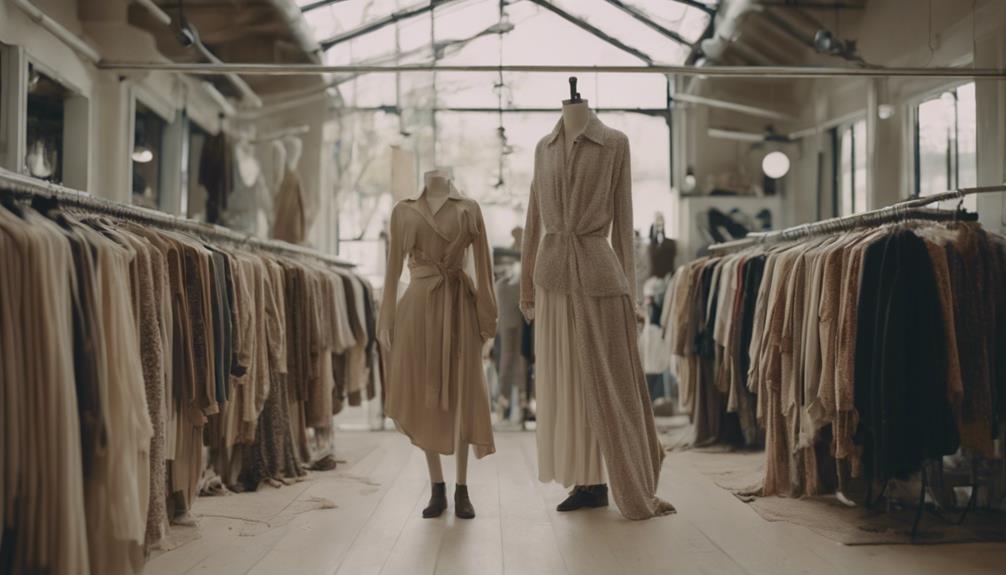
Many consumers mistakenly equate luxury fashion with sustainability, believing that higher prices guarantee ethical production and environmental responsibility. However, this perception overlooks vital realities. The 2022 BoF Sustainability Index revealed that luxury brands only marginally outperform fast fashion in sustainability scores, challenging the assumption that luxury equals responsibility.
| Aspect | Luxury Brands |
|---|---|
| Sustainability Scores | Marginally better than fast fashion |
| Production Volume | Often resource-intensive |
| Supply Chain | Lacks transparency |
| Consumer Perception | Misleadingly equates price with ethics |
Despite their higher price tags, many luxury brands produce large quantities of resource-intensive products, contributing to environmental degradation. Additionally, while consumer demand for transparency is on the rise, many luxury brands remain opaque about their supply chains, ignoring concerns about labor practices and environmental impact. This perception that luxury fashion is inherently sustainable can perpetuate elitism, obscuring the systemic issues present in both luxury and fast fashion sectors. It's essential to critically evaluate the sustainability claims of luxury brands, rather than assuming that higher prices alone guarantee ethical practices.
The Role of Consumer Mindset
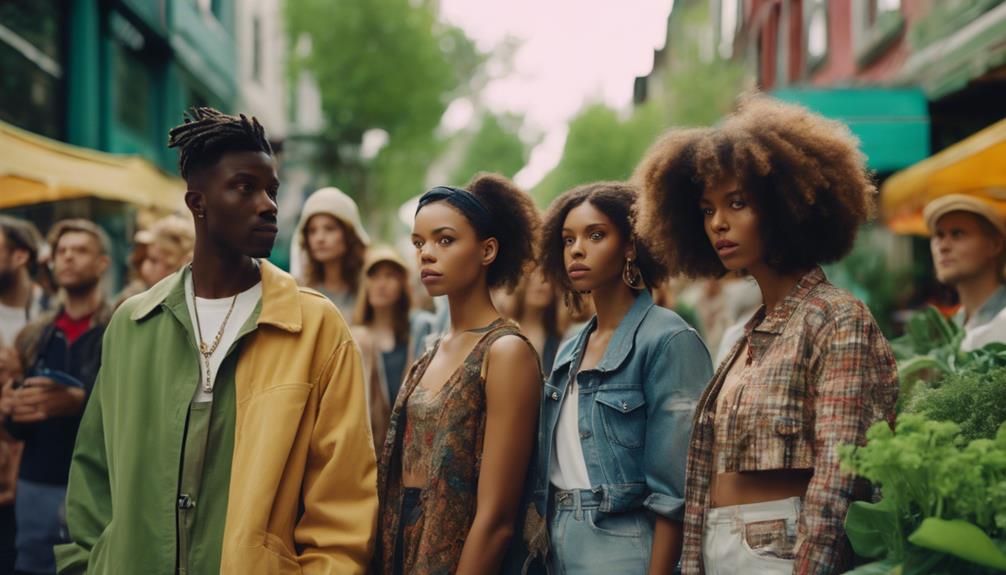
Your mindset around purchasing can greatly impact sustainability in fashion.
When you prioritize trendy items over mindful choices, you contribute to overconsumption and waste.
It's crucial to shift your perception of sustainability to value quality and durability, rather than constantly seeking new pieces.
Mindful Purchasing Habits
Adopting mindful purchasing habits means critically evaluating our choices and embracing quality over quantity in fashion consumption.
It's crucial to recognize that sustainable fashion isn't just about buying eco-friendly brands; it's about rethinking our overall consumption habits. By focusing on durable and timeless pieces, you can greatly reduce waste and promote sustainability.
Here are some strategies to help you cultivate mindful purchasing habits:
- Prioritize second-hand shopping: Thrift stores and online platforms offer unique finds that extend the life of garments while minimizing environmental impact.
- Embrace clothing mending: Learning basic sewing skills can help you repair and maintain your clothes, reducing the need to buy new items.
As you shift towards these mindful purchasing habits, you'll not only contribute to sustainable fashion but also create a more intentional wardrobe that reflects your values.
Perceptions of Sustainability
Mindful purchasing habits can illuminate how consumer perceptions of sustainability often reflect class disparities, affecting access and engagement with ethical fashion choices. You might notice that sustainable fashion is frequently linked to higher price points, making it less accessible for those with limited financial resources. This perception can create a barrier, pushing sustainable options out of reach for many.
| Class Level | Sustainable Fashion Perception | Economic Realities |
|---|---|---|
| Working-Class | Often seen as elitist | Struggles to afford basics |
| Middle-Class | Balances values and costs | Caught between choices |
| Upper-Class | Embraces luxury sustainability | Can choose without concern |
Fast fashion's allure complicates this landscape, as many affluent consumers contribute notably to its carbon footprint. While sustainability discussions often focus on individual responsibility, they can inadvertently shift blame from corporations to consumers, ignoring systemic economic realities that impact marginalized groups. Ultimately, understanding these perceptions is essential in addressing the classism inherent in sustainable fashion dialogues, ensuring inclusivity for all.
Ethical Consumption and Classism
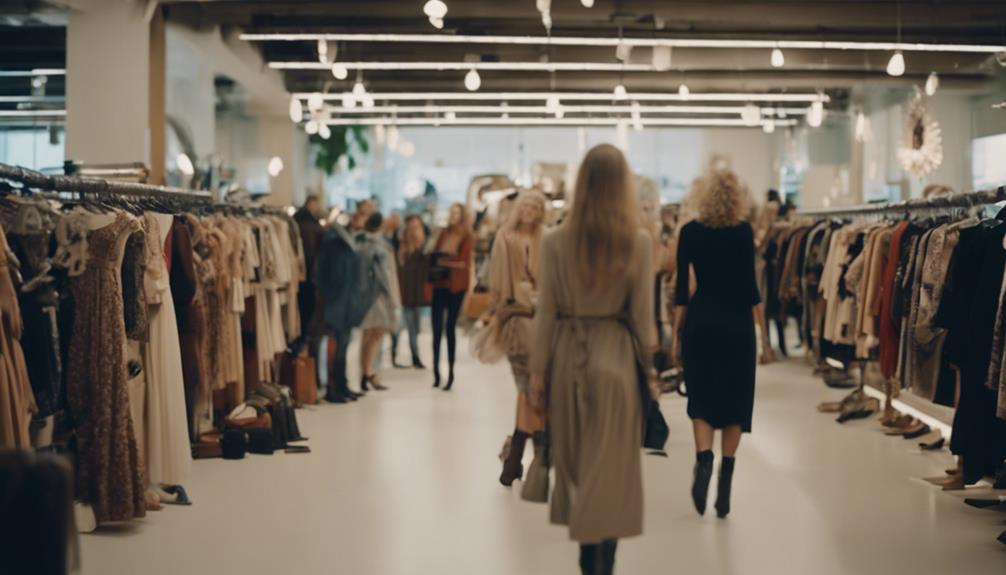
When you think about ethical consumption, it's crucial to recognize the economic barriers that many face in accessing sustainable options.
Class privilege often shapes your choices in fashion, making ethical brands feel out of reach for those on tighter budgets.
Economic Barriers to Sustainability
Economic barriers considerably hinder access to sustainable fashion, often leaving low-income consumers trapped in a cycle of fast fashion due to affordability constraints. When you're on a tight budget, opting for cheaper, disposable clothing becomes a necessity rather than a choice. Many ethical brands come with higher price tags that reflect fair wages and eco-friendly materials, making them inaccessible for those who need to prioritize their spending.
Consider these points:
- Over 3.6 billion clothes are left unworn in the UK each year, showcasing the purchasing habits of working-class families who often can't afford sustainable options.
- Sustainable fashion ideals might seem appealing, yet the economic realities for low-income individuals force them into fast fashion cycles.
The blame for fast fashion's dominance lies in these economic barriers, which push marginalized communities away from sustainable alternatives while complicating discussions around inclusivity in the sustainability movement.
Class Privilege in Fashion
Class privilege shapes the landscape of sustainable fashion, making ethical consumption appear as a luxury that many low-income individuals simply can't access. While sustainable brands focus on fair wages and eco-friendly materials, their higher price points push them out of reach for many. Fast fashion exploits this dynamic, targeting economically disadvantaged groups who often prioritize affordability over ethics, perpetuating a cycle of classism.
| Fast Fashion | Sustainable Fashion | Impact on Society |
|---|---|---|
| Affordable for all | Often unaffordable | Reinforces class divides |
| Low-quality garments | High-quality, lasting items | Environmental degradation |
| Targets low-income groups | Alienates working-class | Marginalized communities ignored |
You might be surprised to learn that over 3.6 billion clothes are left unworn in the UK each year, highlighting the stark contrast between those who can shop sustainably and those who can't. Conversations about sustainable fashion must address class privilege, recognizing that marginalized communities often practice sustainability out of necessity, not choice. It's time to rethink how we discuss ethical consumption and inclusivity in this movement.
Accessibility of Ethical Choices
Accessing ethical fashion choices often feels impossible for those on tight budgets, leaving many to choose affordability over sustainability. Financial constraints considerably limit your ability to afford ethical brands, which typically come with higher price tags due to fair wages and eco-friendly materials. This creates a frustrating divide, as sustainable fashion is frequently seen as an option only for middle to high-income families, alienating working-class individuals.
You might be surprised to learn that in the UK alone, over 3.6 billion clothes go unworn every year. This statistic highlights the disconnect between consumer behavior and the accessibility of sustainable options. Furthermore, conversations about ethical consumption often overlook the economic barriers faced by marginalized communities, perpetuating classism within the sustainability movement.
To help navigate this challenging landscape, consider the following:
- Look for second-hand stores where you can find affordable, ethical choices.
- Research local brands committed to sustainability at lower price points.
In this way, you can take steps toward making ethical choices without breaking the bank.
Marginalized Voices in Fashion

Many overlook the vital contributions of marginalized voices in fashion, particularly those from the Black community, which have profoundly influenced modern trends. The roots of many styles you admire can often be traced back to these communities, yet their impact remains unrecognized in the industry. This lack of acknowledgment perpetuates systemic inequities and continues to reinforce elitism.
Understanding the historical context, such as the connection between denim and indigo to slavery, is key in addressing human rights issues within fashion. Fast fashion thrives on the exploitation of marginalized individuals, and recognizing their contributions is a step toward dismantling these injustices. Initiatives like the Heart Broken Zine highlight the importance of amplifying Black voices in sustainable fashion discussions.
Additionally, educational resources, such as podcasts like 'The Root: Decolonising the Sustainable Fashion Agenda,' promote a broader understanding of sustainability by addressing racial and cultural contexts. Engaging with these diverse narratives not only enriches your perspective on fashion but also fosters inclusivity.
It's time to uplift marginalized voices and make sure they're integral to the conversation surrounding sustainability in fashion.
Rethinking Sustainability and Inclusion

To create a truly inclusive sustainable fashion movement, we must acknowledge the financial barriers that prevent lower-income consumers from participating in ethical consumption. Sustainable fashion often appears elitist due to higher price points, sidelining those who prioritize affordability. The economic realities faced by working-class families can make ethical choices feel out of reach, highlighting the urgent need for inclusivity in sustainability discussions.
You can help shift the narrative by considering these points:
- Recognize that many lower-income consumers practice sustainability out of necessity, not choice.
- Advocate for brands to offer more affordable, eco-friendly options that cater to diverse economic backgrounds.
Addressing these challenges is vital for a movement that truly embodies inclusivity. By understanding the barriers and advocating for change, you can play a role in making sustainable fashion accessible to everyone.
Let's work together to create a future where ethical consumption isn't just a privilege but a choice available to all, regardless of their financial situation.
Frequently Asked Questions
What Is the Problem With Sustainable Fashion?
Sustainable fashion often struggles with accessibility. You might find ethical brands too expensive, forcing you to choose affordability over sustainability. This disconnect can alienate many, creating a barrier to meaningful participation in the movement.
Do People Really Care About Sustainable Fashion?
You might care about sustainable fashion, recognizing its importance for the environment. However, affordability often takes precedence, leading many to prioritize cheap, fast fashion options over more ethical choices, despite your growing awareness of sustainability issues.
What Is the Paradox of Sustainable Fashion?
Sustainable fashion dances on a tightrope, balancing ideals and accessibility. You see the beauty in eco-friendly choices, yet the price tag feels like a weight, leaving you torn between conscience and budget, a paradox indeed.
Why Most of Fashion Today Is Not Sustainable?
Most fashion today isn't sustainable because brands prioritize profit over ethics. You see rapid trends and overproduction, leading to waste. Plus, misleading claims about sustainability confuse you, making it hard to shop responsibly.
Conclusion
As you step into the world of sustainable fashion, picture a vibrant tapestry woven with threads of inclusivity and diversity.
It's time to break down barriers and embrace a style that transcends class, where every voice matters and every choice counts.
By supporting brands that uplift marginalized communities, you can paint a brighter future for fashion—one that's not just chic but truly equitable.
Let your wardrobe reflect not just your taste, but your commitment to a better world.
